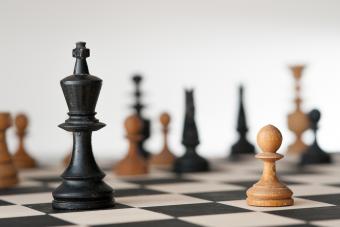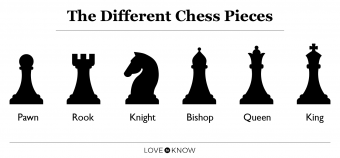
There's this common misconception that chess is meant to be learned at a young age and that if you start playing past elementary school, you've lost all hope of ever grasping the game. Thankfully, this couldn't be farther from the truth; no matter your age, you can learn the basic rules of chess and work your way towards becoming a strong competitor. Don't let the chess community's historic gatekeeping prevent you from pursuing the game.
The Objective of Chess
Fundamentally a strategy game, the purpose of a game of chess is for you to capture your opponent's king. Highly skilled players might be more interested in completing their games with a draw, but most beginners will have a chance to fully 'check' their opponent's kings. You achieve this goal by moving your different pieces around the board, one piece per turn, and placing them in such patterns to defend your own valuable tokens while also attacking your opponent's pieces as well.
How to Set Up the Board

Setting up a chess board to get ready for a match is incredibly easy to do. Make sure that the bottom left corner of the board that's facing you and your opponent is a dark square.
- Place your rooks on each of the outermost squares of the row closest to you, and work your way in.
- Put your knights, bishops, and then king and queen standing next to each other.
- Place all of your pawns on the second row from the row closest to you, one piece per square.
Your opponent will do the same until there are four empty rows in between each of your rows of pawns.
Chess Pieces and Their Movements
Once chess sets and movements were standardized in the 19th century, the metaphorical playing fields were leveled in such a way that every player would have the opportunity to flex their skills to the best of their abilities. In modern chess, each side has the same number of pieces and situates them exactly the same on either sides of the board.

Vitalii Barida / iStock / Getty Images Plus - Modifications made by LoveToKnow Chess pieces and their names
Thus, in the beginning of a game, each player situates their sixteen pieces on the board, with the leftmost corner facing each opponent being a dark square. These pieces include eight pawns, two rooks, two knights, two bishops, one queen, and one king.
Pawns
Pawns are colloquially viewed as expendable pieces. However, these small tokens can be incredibly useful in building both defensive and offensive structures around the board to help you secure your eventual win. Pawns are vital pieces as they open up a game of chess, often being placed on the d4 or e4 squares on the board. According to the rules, pawns are only allowed to move one space ahead and one space diagonally after they make the opening move. This one space rule was adjusted to help shorten what was once multi-day game by allowing the pawn to move forwards two spaces in their opening move.
Rooks
Named the rook, though most non-chess players know it as the castle, this piece is one of the most powerful pieces on the board in terms of its movement capabilities. Rooks are permitted to move as far forward, backward, or side to side for however many open spaces they want to. Although they can't move diagonally, this wide swath that rooks are able to travel around the board makes them incredibly useful offensive tools.
Knights
Knights serve both defensive and offensive roles and have the unique ability of moving around pieces in a way that the other tokens in chess cannot. Knights are restricted to moving in an 'L' shape; sometimes described as a 2-1, this means that the knight can move two squares up, down, left, or right, and one more space to complete this 'L.'
Bishops
Vaguely resembling old train whistles, the appearance of a bishop on the board signifies deep historic connections between the church and the state. In terms of movement, bishops are able to move forwards or backwards on the diagonal as many open squares as they'd like.
The Queen
The queen wasn't always known as the powerhouse piece that it is today, getting a makeover during the Medieval period. The queen can move anywhere on the board and attack whichever piece she likes to. The only caveat to her movements is that she has to move either forward, backward, or on the diagonal and cannot move in the 'L' shape that is designated for knights.
The King
Although the king isn't the most powerful piece in the game, he's the most important piece of the game because once he's been captured, the game is complete. In terms of movement, the king can only move one space in any direction per turn, though there is a special first move rule called castling that can be employed, which allows it to move two spaces instead of one.
Chess Strategy

Ultimately, chess is a strategy game where you need to consider not only the move you're currently making but the moves that can be made in response and how you're going to react in turn. Getting into the habit of thinking ahead with your moves is a great way to start off your chess playing journey. Chess theory generally breaks down the game into three separate sections: opening, midgame, and endgame. They're relatively self-explanatory for what parts of the game they represent, but there are tons of different approaches in the professional chess discourse for tactical sequences to help you dominate your opponent.
Pro tip: It's never too early to start reading the literature about chess and reviewing past games. Getting a grasp for how the masters play chess might feel overwhelming, but reading up on Morphy or Capablanca can give you a holistic understanding of the game that you can't get as quickly by playing it from match to match.
Some other beginner strategies to keep in mind include:
- Develop your pieces quickly - Try to put your hand on - and move - each of your pieces early in the game. The quicker you get them onto the board, the faster you can begin building structures and advancing the round.
- Take control of the center - The middle of the game board is where most of the action in matches occurs. If you can control the center, you can keep your opponent on the defensive rather than the offensive and systematically take their pieces one by one.
- Don't be afraid to sacrifice - Making sacrifices might seem like a scary prospect in chess, but stretching the limits of your skills using fewer pieces can be a wonderful practice for beginners to try out.
Unique Chess Rules
Beyond following the movement rules and making sure that you're only moving one piece per turn, there are a couple of different situations which can arise in chess that beginners should become familiar with.
Castling
Castling is a special move that essentially allows for two moves in one turn. You can castle so long as neither the king nor the rook has made a move yet. Thus, the king moves two spaces to the left or the right, and the rook passes over the king and moves to the left or right to protect him depending on which rook you're using. This is a great way to get the king out of the center of the board and into a more defendable position.
Promotion
Promotion is an interesting rule that emulates every senior's favorite pastime - checkers. If you get one of your pawns moved to the furthest row from its starting position, either the first or eighth depending on your color, you get to replace it with a knight, rook, bishop, or queen of your choice.
En Passant
Occasionally, the initial pawns positioned in the opening moves might end up beside each other, meaning that they're unable to be captured. Thus, as one of these pawn's 'pass' by the other pawn, the opponent can take it as it passes, but it must be done so immediately.
Drawing
Although it's not as ideal as winning a game outright, finishing a game with a draw is still an admirable feat. There are a few different cases in which a draw can occur:
- A stalemate position is achieved when, during a player's move, the king is not checked but has no legal move.
- Both players agree to finish with a draw.
- There are not enough pieces left on the board to create a checkmate.
- The same sequence of movements has been made three times.
- When fifty consecutive moves have been made where neither player has moved a pawn or captured a piece.
Grandmasters Were Amateurs Once Too
One of the most encouraging things to remember if you get overwhelmed by this centuries-old game is that every grandmaster you've ever heard of was once a novice, too. They also had to learn the basics of chess and every rule that you're going over as well in order to become the titans of the game that they've risen to become today. So, when it comes to learning chess, above all else, never give up and keep practicing.







